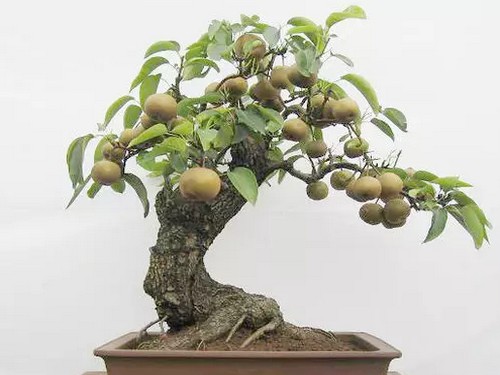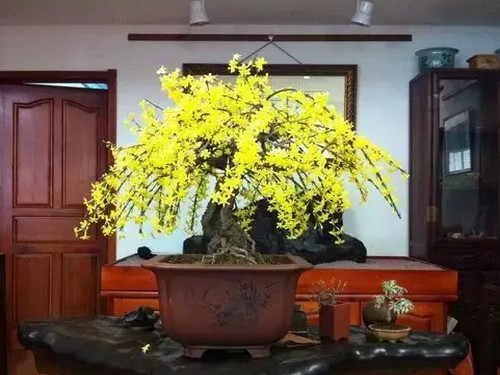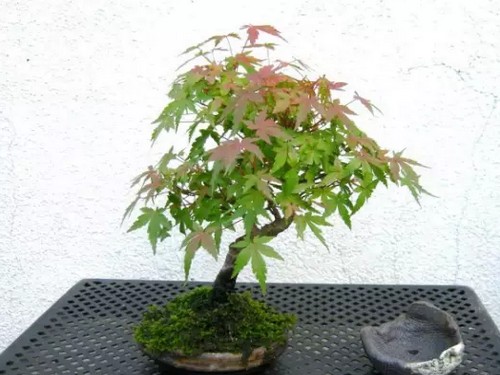Selection of pear bonsai
Pear trees are suitable for making many different forms of bonsai, such as direct dry type, oblique dry type, curved dry type, double dry type, jungle type, facing water type, horizontal dry type and so on. The root system of pear tree is well developed, which can be raised according to the need to increase the artistic conception of the vicissitudes of bonsai.
There are many rootstocks suitable for pears, such as mountain pear, du pear, etc., which can not only be propagated, but also easy to be collected in the mountain area. When collecting in the mountain field, the mountain pear is a better pear rootstock, and its growth potential is strong, and its root system is well developed. when it is returned to the nursery or directly installed in the basin after harvest, the survival rate is high. The purpose of rapid growth and prototyping can be achieved by using small trees or large seedlings with lower branching points in the garden, moderately re-cutting their branches and roots, and directly installing pots to protect them.

For the reproduction of pear trees, Qiuzi pear, Shanli pear, du pear and pear pear can be selected as rootstocks. Pear varieties with strong growth, good quality and easy to hang fruit are used as scions and grafted by bud grafting or branch grafting. The rootstock can not only be propagated artificially, but also use the old pear trees eliminated in the orchard or dig up the old stakes of small, peculiar, low-branched, simple and vigorous mountain pears, which can be rejuvenated by "raising billet" to make them grow new branches and then grafted.
The stump is generally excavated and transplanted after falling leaves in autumn or before germination in spring, first planted in the ground or in a larger tile basin, reshape the plant before planting, cut off the overlong main root, retain the lateral root and whisker root, and cut off the excess branches. After planting, pour water thoroughly and keep it in a place away from the wind and the sun to ensure survival.
After the tree shape is basically stable, attention should be paid to maintaining the vigorous growth of the tree potential to make it bear fruit year after year, combined with pruning and shaping, cutting off overgrown branches, cross branches, overlapping branches and dead branches, cutting short strong and strong branches, and promoting the sprouting of the lower part to develop into branches. to cultivate compact fruiting branches. And make the bonsai clear, dense and elegant, so as to achieve a natural and beautiful artistic effect.
Time: 2019-06-02 Click:
- Prev

Selection and cultivation of primrose bonsai
Primrose is the Spring Festival Jiahui that Lingchun sends early. She grew up in the courtyard wall or roadside flower bed, not conspicuous, until the beginning of the Spring Festival, she opened her arms into the embrace of spring, the first to blossom to meet the brilliant spring. But she is not self-confident, not proud, not to show off the heroes of spring, but to embellish the spring together with flowers.
- Next

Selection of bonsai of Acer truncatum
Acer frutescens is produced in the provinces of the middle and lower reaches of the Yangtze River Basin in China, as well as in Shandong and Zhejiang. It's distributed in Japan. It is a common ornamental tree species in the garden, and there are many wild trees in the mountains. Like light, like warm and humid climate, not very cold-resistant, suitable for humus-rich, fertile and moist acidic or neutral soil. Potted plants should be protected from the west and direct sunlight.
Related
- Fuxing push coffee new agricultural production and marketing class: lack of small-scale processing plants
- Jujube rice field leisure farm deep ploughing Yilan for five years to create a space for organic food and play
- Nongyu Farm-A trial of organic papaya for brave women with advanced technology
- Four points for attention in the prevention and control of diseases and insect pests of edible fungi
- How to add nutrient solution to Edible Fungi
- Is there any good way to control edible fungus mites?
- Open Inoculation Technology of Edible Fungi
- Is there any clever way to use fertilizer for edible fungus in winter?
- What agents are used to kill the pathogens of edible fungi in the mushroom shed?
- Rapid drying of Edible Fungi

